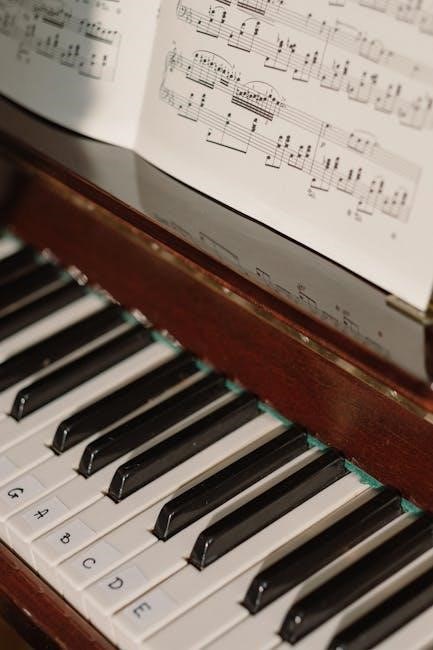Nothing Else Matters Sheet Music Piano PDF: A Comprehensive Guide

Embark on a musical journey with our comprehensive guide to “Nothing Else Matters” sheet music for piano. This resource navigates the vast landscape of available PDFs, offering insights for beginners to advanced players. Discover arrangements, notation tips, and where to find the perfect sheet music.
“Nothing Else Matters,” a timeless ballad by Metallica, has captivated audiences worldwide since its release in 1992. Its poignant melody and heartfelt lyrics resonate with listeners of all ages, solidifying its place as a classic. The song’s popularity extends beyond the rock genre, inspiring countless covers and arrangements across diverse musical styles.
Originally written for guitar, “Nothing Else Matters” lends itself beautifully to piano arrangements. Its simple yet elegant structure allows for expressive interpretation, making it a favorite among pianists of varying skill levels. The availability of sheet music in PDF format has further fueled its popularity, providing easy access for musicians to learn and perform this iconic song.
The song’s universal themes of love, trust, and vulnerability contribute to its enduring appeal. Whether performed as a solo piano piece or accompanied by vocals, “Nothing Else Matters” evokes a sense of intimacy and emotional depth, making it a cherished piece in the repertoire of many musicians.
Availability of Sheet Music for Piano
The sheet music for “Nothing Else Matters” for piano is widely available in various formats, catering to different skill levels and preferences. Thanks to the internet, numerous websites offer digital sheet music in PDF format, making it easily accessible for musicians worldwide. These resources range from free downloads to paid arrangements, providing options for every budget.
Sheet music platforms such as Sheet Music Plus and Virtual Sheet Music offer professionally arranged versions, often with interactive features like transposition and tempo control. Musescore is another popular platform where users can share and download sheet music, including various arrangements of “Nothing Else Matters.” For those seeking a more traditional approach, physical sheet music books are also available from retailers like Hal Leonard.
Whether you’re a beginner looking for a simplified version or an advanced pianist seeking a challenging arrangement, there’s a wealth of options available. The key is to explore different resources and find the sheet music that best suits your skill level and musical taste.
Free Sheet Music Resources Online

Numerous online platforms offer free sheet music for “Nothing Else Matters,” providing aspiring pianists with accessible resources. These platforms operate on a community-based model, where users share and download arrangements, catering to various skill levels. Websites like Musescore boast user-generated content, with multiple renditions of the song for piano.
However, quality varies significantly across these free resources. Some arrangements might be simplified or inaccurate, so exercising caution and cross-referencing with other sources is essential. IMSLP (International Music Score Library Project) is another valuable resource, hosting public domain sheet music and user-submitted arrangements.
While free resources offer an excellent starting point, remember to consider the arrangement’s accuracy and suitability for your skill level. Many free options are transcriptions by enthusiasts, and may not be professionally edited. Always check for clarity and correct notation to ensure a smooth and enjoyable learning experience. These free platforms provide a great opportunity to explore different arrangements without financial commitment.
Paid Sheet Music Options
For pianists seeking higher-quality and more accurate sheet music for “Nothing Else Matters,” paid options offer a reliable alternative. Established sheet music retailers like Sheet Music Plus and Virtual Sheet Music provide professionally transcribed and edited arrangements. These arrangements often include features like fingering suggestions, dynamic markings, and articulation, enhancing the learning experience.
Paid sheet music options also boast a wider range of arrangements, catering to different skill levels and musical styles. You can find simplified versions for beginners, intricate solo piano arrangements for advanced players, and even versions for piano and voice. Platforms like Musicnotes offer official arrangements licensed directly from the copyright holders, ensuring accuracy and respect for intellectual property.
Investing in paid sheet music often guarantees a better learning experience and a more polished performance. The clarity and accuracy of the notation, combined with helpful annotations, can save time and frustration. Furthermore, purchasing sheet music supports the composers and arrangers who create these valuable resources, encouraging continued musical innovation.
Different Arrangements and Skill Levels
“Nothing Else Matters,” a timeless classic, enjoys a vast array of piano arrangements tailored to diverse skill levels. This ensures that pianists of all abilities can experience the joy of playing this iconic piece. Beginner arrangements often focus on simplified melodies and basic chord progressions, making the song accessible to those with limited experience.
Intermediate arrangements introduce more complex harmonies, rhythms, and fingerings, challenging players to expand their technical skills. These versions may incorporate elements of the original guitar arrangement, adding depth and texture to the piano rendition. Advanced arrangements, on the other hand, showcase virtuosic techniques, intricate countermelodies, and demanding passages, designed for seasoned pianists seeking a challenging and rewarding performance piece.
When selecting a “Nothing Else Matters” piano sheet music PDF, it’s crucial to consider your current skill level. Choosing an arrangement that is too difficult can lead to frustration and discouragement, while selecting one that is too easy may not provide sufficient challenge or musical satisfaction.
Beginner Piano Arrangements
For aspiring pianists eager to play “Nothing Else Matters,” beginner piano arrangements offer an accessible entry point. These simplified versions prioritize ease of learning, focusing on the song’s core melody and basic harmonic structure. Typically, beginner arrangements feature single-note melodies in the right hand, supported by simple chords in the left hand.
The chords are often presented in root position, using only the most fundamental triads. Rhythmic complexities are minimized, with straightforward patterns that are easy to grasp. Fingerings are clearly indicated to guide beginners in developing proper technique. These arrangements are designed to build confidence and provide a sense of accomplishment, enabling beginners to enjoy playing a recognizable and beloved song;

Many beginner piano arrangements of “Nothing Else Matters” are available as free PDF downloads online. These resources often include helpful annotations, such as chord symbols and lyrics, further aiding the learning process. With dedication and practice, beginners can quickly master these arrangements and progress to more challenging versions.
Intermediate Piano Arrangements
Intermediate piano arrangements of “Nothing Else Matters” bridge the gap between simplified beginner versions and complex advanced interpretations. These arrangements introduce greater harmonic and rhythmic sophistication, challenging pianists to expand their technical skills and musical expression.
Intermediate arrangements often feature richer chord voicings, incorporating inversions and seventh chords to add depth and color to the music. The left-hand accompaniment may include arpeggios, broken chords, or more intricate rhythmic patterns. Melodic embellishments, such as grace notes and trills, are also common, enhancing the song’s lyrical quality. These arrangements demand greater finger dexterity, coordination, and an understanding of musical phrasing.
Many intermediate arrangements are available as PDF downloads, both free and paid. These resources often include detailed performance notes, offering insights into interpretation and technique. With diligent practice, intermediate pianists can develop their musical artistry and create a compelling performance of “Nothing Else Matters.” They represent a significant step forward in piano proficiency.
Advanced Piano Arrangements
Advanced piano arrangements of “Nothing Else Matters” represent the pinnacle of complexity and artistry, designed for seasoned pianists with exceptional technical skills and a deep understanding of music theory. These arrangements transcend simple note-for-note transcriptions, often incorporating elaborate embellishments, intricate countermelodies, and sophisticated harmonic variations.
Expect to encounter challenging techniques such as rapid arpeggios, complex chord voicings spanning wide intervals, and demanding rhythmic patterns. Advanced arrangements may also feature improvisational sections, encouraging pianists to explore their own creative interpretations of the melody and harmony. These versions often demand a high level of finger independence, precise pedaling control, and a nuanced understanding of dynamics and phrasing.

Finding suitable sheet music PDFs for advanced arrangements may require searching specialized online resources or music libraries. These scores often include detailed performance notes, offering insights into the arranger’s artistic intentions and providing guidance on tackling the most challenging passages. Mastering an advanced arrangement of “Nothing Else Matters” is a rewarding achievement.
Key Features to Look for in Sheet Music PDF
When searching for “Nothing Else Matters” sheet music in PDF format, several key features can significantly impact your learning and performance experience. Clarity and legibility are paramount. Ensure the PDF is high-resolution, with clear notation, easily readable notes, and sharp symbols. Pay attention to the font size and spacing; cramped or blurry scores can hinder your progress.
Accurate notation is crucial. Verify that the sheet music accurately reflects the original composition, including correct notes, rhythms, dynamics, and articulation markings. Look for reputable sources or publishers known for their meticulous transcriptions. A well-formatted PDF will also include essential information such as the title, composer/arranger, key signature, time signature, and tempo markings.
Consider the arrangement’s suitability for your skill level. Beginner arrangements should have simplified rhythms and chords, while advanced arrangements will feature more complex harmonies and techniques. Interactive features like embedded audio or MIDI files can be beneficial for learning and practice. Finally, check for transposition options if you need to play in a different key.
Transposition Options
Transposition, the process of shifting a piece of music to a different key, is a valuable feature to consider when selecting “Nothing Else Matters” sheet music in PDF format. Transposition allows you to adapt the song to your vocal range or to the capabilities of your instrument. Many sheet music providers offer transposition options, either as a built-in feature or as separate versions of the score in different keys.
When looking for transposition options, consider whether you need a simple key change or a more complex arrangement. Some PDFs may offer a limited number of transpositions, while others allow you to choose any key. Interactive sheet music platforms often provide real-time transposition, allowing you to instantly hear the music in the new key.
Be aware that transposition can affect the overall sound and feel of the song. While “Nothing Else Matters” is typically played in E minor, transposing it to a brighter key like C major can give it a different character. Experiment with different keys to find the one that best suits your preferences and the context of your performance.
Interactive Features
Interactive features in digital sheet music PDFs can significantly enhance your learning and playing experience, particularly with a complex piece like “Nothing Else Matters.” These features go beyond static notation, offering tools for customization and practice. One common interactive feature is the ability to adjust the tempo. Slowing down the music allows you to master difficult passages at your own pace before gradually increasing the speed.
Another valuable interactive feature is the ability to isolate specific sections of the song for focused practice. Looping a challenging measure or phrase helps you build muscle memory and improve accuracy. Some interactive platforms also offer the ability to highlight notes or add annotations, making it easier to track your progress and remember important details.
Furthermore, interactive sheet music may include playback options, allowing you to hear the music played by a virtual instrument. This can be especially helpful for understanding the rhythm and phrasing of “Nothing Else Matters.” Look for sheet music providers that offer these interactive features to maximize your learning potential and make the practice process more engaging.
Understanding Notation and Symbols
Navigating the world of sheet music requires a solid grasp of musical notation and symbols. For “Nothing Else Matters,” understanding these elements is crucial for accurately interpreting the composer’s intentions and delivering a compelling performance. Basic notation includes recognizing notes on the staff, understanding their duration (whole, half, quarter, etc.), and interpreting time signatures. Time signatures, like 4/4, indicate the number of beats per measure and the type of note that receives one beat.
Beyond the basics, be aware of accidentals (sharps, flats, and naturals), which alter the pitch of a note; Dynamics (p, mf, f) dictate the volume at which to play, while articulation markings (staccato, legato) indicate how to play each note. Also, pay attention to repeats, codas, and other structural symbols that guide the flow of the music.
For piano music, understanding the relationship between the treble and bass clefs is vital. The treble clef typically represents the right hand, while the bass clef represents the left. By carefully studying the notation and symbols in your “Nothing Else Matters” sheet music PDF, you can unlock the song’s full potential.
In conclusion, the quest for the perfect “Nothing Else Matters” sheet music PDF is a personal journey, shaped by your individual skill level, musical preferences, and desired arrangement. Whether you’re a beginner seeking simplified notation or an advanced pianist craving a challenging rendition, numerous options are available.
Remember to consider factors like the arrangement’s complexity, the accuracy of the transcription, and the presence of helpful features like fingering suggestions or interactive playback. Explore both free and paid resources, carefully evaluating the quality and suitability of each before committing.
Don’t be afraid to experiment with different arrangements and transpositions to find the key and style that best suit your voice and playing ability. Ultimately, the “perfect” sheet music is the one that inspires you to play and allows you to connect with the music in a meaningful way. Happy playing!

